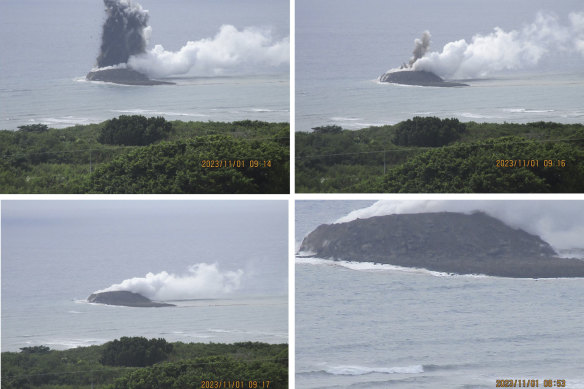
Save articles for later
Add articles to your saved list and come back to them any time.
Tokyo: Three weeks ago, the view from Iwo Jima showed open ocean. Now there’s a tiny new island right offshore, billowing smoke as it grows and offering a rare glimpse at how volcanic islands emerge.
The new island is the product of an unnamed undersea volcano that began erupting on October 21, about a kilometre from Iwo Jima, the island in Japan where American and Japanese forces waged a fierce battle during World War II.
No injuries or damages have been reported on Iwo Jima, hundreds of kilometres from Tokyo in the Pacific Ocean, since the ongoing eruption began, but it is offering an eye-opening real-time view of a rare geological phenomenon.
Similar eruptions occurred last year in the same spot, but this time the eruption point is above the water’s surface, said Yuji Usui, a senior analyst for volcanic activity at the official Japan Meteorological Agency.
“Now that it’s visible,” he said, “people are paying attention.”
There are about 1350 potentially active, land-based volcanoes around the world, according to the US Geological Survey. Scientists have so far discovered thousands more active “submarine” volcanoes, and they believe that there may be many more – possibly hundreds for every one on land – lurking beneath the waves.
Undersea volcanic eruptions have occasionally formed major islands, including those of the Hawaiian archipelago, throughout geological history. But most of the time, people don’t get to witness these eruptions happening.
“The eruptions that formed Hawaii were all before our time,” said James White, a professor of geology at the University of Otago in New Zealand who has studied undersea volcanic eruptions. “But also, until it got up to the water’s surface, we wouldn’t have seen them even if we’d been sitting above them in a Polynesian canoe.”
The current eruption off Iwo Jima intensified for weeks and peaked last Friday and Saturday, Usui said. The new island was about 100 metres in diameter as of October 30, according to a report by the Earthquake Research Institute at the University of Tokyo.
Another small island formed in a similar way in the same region of Japan, near the Nishinoshima volcano, in 2013. That eruption lasted for a decade, but eruptions near Iwo Jima typically only last for a month, said Setsuya Nakada, a professor emeritus at the institute.
“It’s hard to know when it will stop, but assuming the eruption continues, the island could grow higher and bigger,” he said.
White said the current eruption appears to have started on the flank of a larger “parent” volcano that rises through about a third of a mile of seawater and whose summit is exposed as Iwo Jima.
Instead of creating a sustained eruption column, the eruption is producing discrete explosions in fingerlike jets where large gray particles suck smaller ones along as they travel in a cannonball-like ballistic arc, White said. The eruption also includes red-hot pieces of magma, and the mix of material illustrates the eruption’s complexity, he added.
“Even as volcanologists, it’s tricky to say exactly how that’s working,” he said.
Many Americans know Iwo Jima because the island, which is part of a chain, was the site of a deadly World War II battle in early 1945. A Pulitzer Prize-winning photograph showing five US Marines and a Navy corpsman raising the American flag over the island in February 1945 became an indelible image of the war for the American public.
The eruption from an underwater volcano in Japan last weekend. The new island is the product of an unnamed undersea volcano that began erupting last month.Credit: Japan SDF, The New York Times
Yuka Takahashi, who lives on Chichi Island, about 130 kiloemtres from the Nishinoshima volcano and about twice as far north from Iwo Jima, said she has sometimes smelt sulfur and smoke from the Nishinoshima eruption.
When Takahashi, 31, saw Iwo Jima in June during an overnight cruise that departed from Chichi, it was surrounded by water, and she did not see – or smell – any sign of an eruption. All she saw was a facility run by Japan’s Self-Defence Forces and a handful of wrecked ships on the beach.
“I wonder if a new island will be formed there permanently or if it will just sink back under the water,” she said of the current eruption. “I’m curious.”
This article originally appeared in The New York Times.
Most Viewed in World
From our partners
Source: Read Full Article
